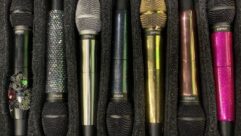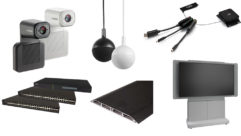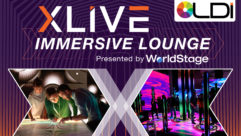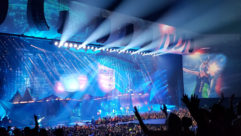
Installation Profile: Vegas Style
Aug 1, 2004 12:00 PM,
By Bennett Liles
Scattered all around the mall’s interior are vertically oriented plasma screens displaying video, stills, maps, and directories.
Visitors on the Las Vegas strip have been provided a new mecca for fashion marketing, and the Rouse Company, developer of the project, couldn’t have picked a better location. Situated down the street from McCarran International Airport and boasting more than a thousand feet of Las Vegas Boulevard frontage, Fashion Show is within walking distance of 75 percent of more than 126,000 hotel rooms and a quick ride for 425,000 local residents who live within five miles of the venue.
“We’re very excited about the project, and we love to talk about it,” says Sharon Bair, the Rouse Company’s marketing director for the Fashion Show Mall. “The mall already had a nice retail lineup, and it did well in terms of sales per square foot primarily because of its place on Las Vegas Boulevard. We selected ‘Impact Source’ as the marketing theme because it’s such an extraordinary venue that we needed to have a naming vehicle that was about more than doing a fashion show in a mall. This is about reaching 35 million visitors in Las Vegas every year along the most heavily traveled street in America.”
And reach, it does. Everywhere there is sight and sound guiding visitors into a courtyard called the Great Hall and enticing them with surround sound and flashing, sliding, and rotating stills and video. The transformation involved installing the most technologically advanced sound, video, and projection system located in any public mall in the world. That has elevated Fashion Show to being one of the Rouse Company’s top investments. As such, its technology is entertainment driven and is constantly being upgraded.
“We launched a very aggressive program,” says Bair. “Wednesday through Sunday, we do seven shows a day. We have a full-time technical crew and a full-time model base that does our fashion shows, and every month we’re tweaking and changing the technology to improve it. We’re changing our creative aspects to make it more interesting for the consumer, and we have the resources behind us to take us in that direction.”
The Cloud’s bottom surface is the most distinct and recognizable architectural element.

The entrance plaza appears to have a giant spaceship from the movie
Independence Day
hovering above it. Known locally as The Cloud, the massive steel-framed, aluminum structure is larger than a football field to offer shade from the relentless desert sun during the day, and its lower, rounded surface acts as a huge overhead projection screen at night. Controlled in concert with four moveable, full-color, high-resolution, Barco 14 mm LED screens, five kiosk-mounted Pigi projectors, 24 Martin Exterior 600 Color Changers, and six Martin Mac 200 Performance fixtures, The Cloud becomes a living giant shouting above the visual din of the Las Vegas Strip to beckon shoppers from miles around.
SIZE MATTERS
Along the Strip, bigger and brighter are not only better, they are essential. The Cloud measures 479 feet long by 160 feet wide and is 21 feet deep at its maximum point. The massive and unconventional structure easily plays its initial role as an attention getter. At its thickest point, The Cloud hovers 93 feet above the street by hanging from two columns rising 185 feet above the 72,000-square-foot entrance plaza. The column footings extend downward through an underground parking and plaza deck. Covering the outside of these are 44-by-24-foot hanging vinyl banners that can be easily seen from the Las Vegas Strip in both directions.
The cleverly engineered structure was not easy to assemble. In order to keep the underside of The Cloud clear for projection, its frame is suspended by a space frame grid consisting of 15 upper cables, 8 lower cables, and 16, 12-inch-diameter pipe compression struts attached to the top of each column. Fastened to the frame is the interlocked aluminum cladding that forms the 1½-acre projection area. According to its maker, Advanced Structures, the cable suspension acts to spread the load and minimize swaying in the desert winds.
The Barco LED screens inside the Great Hall are shown in their lowered configuration.

The first bank of large screens one encounters is composed of the four Barco Dlite LED screens, providing a total of 1,786 square feet of advertising area. Part of an $8.2 million contract with Barco Media of Kennesaw, Georgia, the four 24-by-43-foot LED screens slide along a 400-foot curved track as they operate facing the Strip. These mobile LED displays forming a 160-foot video parade have come to be known as the “dancing video” screens.
The technique used to paint The Cloud’s lower surface with color and advertising is truly distinct. Continuing the multiuse architecture theme, a battery of five projection kiosks houses the Martin Exterior 600s for controlling background colors and the five 6,000W automated, double-rotating Pigi projectors that splash huge ads across the bottom of The Cloud. Spanning the entrance plaza, the projection kiosks include smoked glass domes through which shine the projectors from their enclosed, air-conditioned environment. Also featured are flat, 61-inch Zenith plasma screens that are used to alternately display maps, directories, and live video from the fashion shows inside. Oriented vertically, the plasma screens display content that is scheduled and logged by the DaletPlus control system, played from an Omneon server and distributed to the screens in the form of an SDI signal. Placed in domes atop the 20-foot signage pylons are Mac 2000 Performance instruments that throw advertising gobos and provide added motion and color. But as Bair points out, the technology of this venue is cutting edge and, as such, is always in transition.
“There has been a series of things, both software and hardware, where we’ve gone in and used things, and either the technology has changed or it didn’t quite do what we wanted it to do,” Bair says. “We’re in the process now of changing our Cloud projectors from a film projector to a video projector, and we’re constantly making changes like that.” But on the Cloud projection, film will still play a role.
“We’re actually repurposing the Pigi projectors to some other locations on The Cloud,” says Steve Pospisil, vice president and director of creative content for the Rouse Company. “We aren’t eliminating them. They certainly have an impact, but we are limited by that technology in our ability to provide advertisers an industry-standard electronic affidavit to prove playout of their ads. We could do that with everything except the Pigis, and that is our primary motivation for moving from Pigis to data projectors.” These will be Barco ELM R18s that will add motion video to The Cloud and provide electronic affidavit logging through the DaletPlus control system. “We’re going to put two R18s on each half of the area that we’re projecting on,” says Pospisil.
Sound, video, projection, and motion control are handled from the control balcony that overlooks the Great Hall.

Inside the Great Hall, a central open-air atrium, more video displays splash images and video over visitors seemingly from every direction. Three 7-by-13-foot Barco Ilite 8 (8 mm) LED screens are motion controlled on powered ceiling hoists for added excitement during fashion shows and product debut productions. Naturally, with heavy objects in motion, there are safety concerns.
“There are safety constraints in the software,” says Pospisil, “and then there are hard safety limits on the winches themselves, and there are emergency stops, or
e-stops
, located in various places to be able to, in an emergency, stop them.” He likens this concept to that of the emergency stop cord on a train.
SHOW CONTROL
The media control is provided by the DaletPlus System, and it controls all aspects of content playback throughout the facility. David Starck, project engineer for Ford Audio-Video, assisted in the installation, and he outlined the DaletPlus System’s additional capabilities.
“It is also capable of controlling all ancillary systems such as architectural lighting around the main stage, movement of the four LED screens in the plaza, and it can provide time code to any other system to chase,” says Starck.
The DaletPlus database and storage capabilities allow acquisition of video, graphic, and sound content and playback in any combination. Its asset and traffic management features allow total control of these elements from creation through integration to playback. Especially handy among the Dalet’s general abilities are the features of logging and accounting. Stored metadata associated with each event can generate figures on clientele, usage history, format type, and user rights that may be used for functional evaluation and for client proof-of-performance figures. Authorized users can store their media files and then fill in onscreen forms generated by the DaletPlus Asset Manager to input the associated metadata. All types of media files can be grouped and manipulated as one object, and modifications to the Asset Manager forms can be done on the fly.
The system maintains an all-important capability for easy manual control of an array of show elements through the DaletPlus Carts application. Smoke effects, video, lights, and other effects can be manually triggered. One of the most interesting areas of control is the fact that the entire control network can be run remotely. As Starck explains, this opens up some fascinating possibilities.
Fashion Show Mall models travel the runway beneath the Barco LED screens.

“The most interesting situation came during testing the motion control of the four giant Barco LED screens in the plaza area,” Starck says. “The facility control system, audio system, and video systems all reside on an Ethernet network. We can gain access to this network at any time via a static DSL line. During testing, the software engineer from Dalet was able to connect to the facility from New York City and, through the control system, was able to move the screens from 3,000 miles away. Pretty cool.”
Although the facility is a mall, it incorporates live television production features. Video capabilities include two Hitachi wide-aspect-ratio PTZ cameras with SDI outputs. One of these is mounted at the end of the runway portion of the stage, and the other shoots from the side of the stage. The cameras are controlled by an Eagle pan/tilt touch-screen system. The interface features a 320-by-240 backlit, color LCD with user-adjustable contrast and tilt angle. These units can expand their control to handle as many as 32 cameras, and they can recall up to 64 predefined camera shots from each camera head. A set of joysticks is used to control pan/tilt, zoom, and focus. A mobile handheld camera is sometimes used and is tied into the system by a fiber-optic interface. For commercial TV coverage of events, all sound and video signals can be routed to a truck panel located outside, where ENG and EFP remote crews can connect directly to what is happening inside.
SOUND FOR ANY SHOW
The varied content and moveable architectural elements along the Fashion Show runway posed a challenge requiring an extremely versatile sound system. The mall needed a system that could cover a wide expanse while maintaining tight area control.
“The sound system consists of a set of JBL AE-series main speaker clusters on each side of the main stage,” says Starck. “These are augmented by two sets of delay speakers hung above and along the runway portion of the stage. Additionally, there is a set of delay speakers facing off the rear of the main stage. All of these speakers can be raised or lowered by the automated rigging system, depending on the show requirements. Those speaker systems are complemented by a special part of the BGM [background music] system that surrounds the performance area and can be used as fill or matrixed and used for surround.”
Before the control system was installed, initial testing and checkout began with technicians putting the mall’s production equipment through its paces.

Although fashion shows are rarely live-miked, two Shure wireless microphone systems are available for special requirements. A Shure ULXP4 predictive diversity receiver and a Shure UHF U4D receiver offer a combined, 4-channel wireless mic system. The ULXP4 can be used with the Shure Beta 57 RF handheld mic and a ULX1 belt-pack transmitter. The U4D operates with either a wireless Beta 58 or the ULX1 transmitter. The receivers are located on the Show Control Balcony, where the antennas have an unobstructed view of the entire performing area. The range of programmable frequencies available in the Shure system is vital in such a heavy-RF environment, particularly when technical additions and modifications are always in progress.
“With this configuration,” says Fashion Show technical director Alex Smith, “we have had little to no problems with reception, even given the wide range of other wireless frequencies within our facility.”
An Omneon Video Networks server stores the fashion show sound and video. The content is edited and stored on the Omneon during show pre-production, and then it is played back during the show under the control of the DaletPlus System.
“All audio EQ, routing, and level control is handled by a MediaMatrix system,” says Starck. “The MediaMatrix can be controlled remotely from a computer in the Show Control Balcony that overlooks the performance area. The MediaMatrix system is also tied to the show control system and can receive commands from it during shows to automate the sound.”
The audio-processing gear is located downstairs from the Show Control Balcony. The lower area also houses the power amplifiers for the whole venue except for the plaza. The Crown amplifiers channel their output all the way up into the overhead grid by way of Insul-8 cable reels, and the cables then descend to the four sets of JBL AE-series AM 6315/64 (three-way cabinet biamp) and two AL 6125 subs. Spread around the entire upper level overlooking the runway and stage are 12 JBL Control 29s run by 2 QSC CX-204V 4-channel amplifiers.
The front-of-house console controlling the main sound mix is a Soundcraft Spirit 324 Live Digital console positioned above and at the far downstage end of the runway. This is used in conjunction with two dbx 166A compressors and two dbx 2331 graphic EQ units.
Remote-controlled PTZ cameras can record events in the Great Hall for later playback or send live images to display screens and to the truck panel for live pickup outside.

The Spirit 324 Live Digital seems to be an especially appropriate mixer for this venue. The board was designed specifically to bring all the features of a digital project studio mixer into a live performance environment and make these functions quick and easy to select and use for live performance. The snapshot feature so useful in the small digital boards makes instant changes in setup possible — a must when you’re doing seven live shows a day.Playback devices include Denon CD players, Pioneer DVD decks, VHS and Beta tape machines, satellite TV (DirecTV), as well as the Omneon video server. All of these are fed to the Spirit 324 through MediaMatrix CobraNet and a variety of patch bays. This makes for an extremely agile and adaptable sound system.“I feel that one of the unique things about the audio system in this facility is in its versatile use of components that can be adapted to almost any kind of event held in this space,” says Smith. “The Great Hall is what I describe as a Las Vegas — style show room centered within Las Vegas’s most extravagant shopping experience, Fashion Show.”LIGHTING CONTROLAs is typical with a cutting-edge media project, some of the biggest challenges, handled correctly, are totally transparent to a blissfully unaware public. But the control of such a huge and varied media presentation, particularly where it involves moving trusses and LED panels, requires superbly innovative control technology. To throw intricate, high-resolution lighting control data across empty space and do it reliably, wireless DMX lighting control has been installed at the Fashion Show Mall. But with the RF, there have been a few surprises.“We’re in the process of backing out some of the wireless DMX because we had too much wireless on the property,” says Pospisil. “Each store had the potential of having a wireless network, and with cell phone repeaters and all the other RF devices operating in that space, we started to experience quite frequent interference with it, so we’re pushing out a large percentage of the wireless DMX for hard-wired DMX on cable reels.”The convenience and easy setup of wireless DMX is hard to pass up in such a situation, especially where there are so many large and heavy show elements in motion. However, in such a busy RF environment, that convenience can be turned around into a potential nightmare of self-activating gadgets causing a scene not intended for the show. But Pospisil isn’t forsaking wireless lighting completely.“The reason we went wireless was because we had all of our trusses moving in the space, and the cabling question was very significant, so the wireless DMX was, at the time, the easiest solution to dealing with all these moving light trusses,” he says. “We’re still going to have some wireless in the system. We have some trusses that are way outboard of everything, and we’re going to leave them wireless.”Operating in the 2.4 GHz band, wireless DMX has a range of up to 4 miles with optional antennas, and up to 16 transmitters may be used to convey as many as 8,192 channels. The system is operated through LCD menus and offers onscreen help and full diagnostic status messages. Radio DMX has been praised by operators for its plug-and-play setup and right-from-the-box installation, but as the Fashion Show crew has learned, heavy RF environments can cause otherwise wonderful control systems to produce unpredictable results. In such a venue, RF coordination is critical.The Las Vegas Fashion Show mall has come a long way in its billion-dollar transformation, and its continually upgraded technical systems now set the mark for imaginative technology integration with multiuse architecture.Bennett Lilesis a freelance television production engineer and an audiovisual technician in the Atlanta area. He specializes in government video production, distance learning, and videoconferencing.For More InformationBarco
www.barco.comCrown
www.crownaudio.comDalet
www.dalet.comdbx
www.dbxpro.comDenon
www.usa.denon.comFord Audio-Video
www.fordav.comHitachi
www.hdal.comJBL
www.jblpro.comMartin
www.martinpro.comMedia Matrix
http://mediamatrix.peavey.comOmneon
www.omneon.comPigi
www.etc-pigi.comPioneer
www.pioneerelectronics.comQSC
www.qscaudio.comRouse Company
www.therousecompany.comShure
www.shure.comSoundcraft
www.spiritbysoundcraft.comZenith
www.zenith.com










